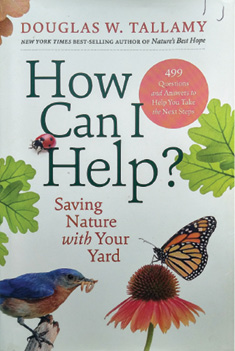Dr. Douglas Tallamy may be doing more than anyone in our time to illuminate the crucial and imperiled interdependence of insects, birds, bees, plants, and the rest of us.
From his perch as a professor of entomology and wildlife ecology at the University of Delaware, Tallamy has given countless presentations (including for the Granby Public Library during the pandemic), founded Homegrown National Park, a national group dedicated to increasing our yards’ potential to support a healthy ecosystem, and written bestsellers like Nature’s Best Hope.
He’s done it again. How Can I Help? Saving Nature with Your Yard uses 500 questions raised during his presentations to provide detailed, practical, science-backed answers. Here is a sample of his Dos and Don’ts; for more, buy the book, or check out copies at the Granby Public Library.
Don’t …
Don’t pay for fogging or spraying treatments for mosquitoes. Companies like Mosquito Joe use chemicals that kill mosquitos but also their predators, along with monarchs and a host of pollinators. It’s a waste of money that demolishes food supplies for birds, bats, spiders and others. Don’t use bug zappers—99 percent of the insects they kill are not the biting kind.
Don’t kill tent caterpillars or fall webworms. These are native and turn into night-flying moths, important food sources for bats and birds. They are eruptive—plentiful one year and sparse the next—and don’t greatly harm their tree or shrub hosts. Don’t brush off outdoor spider webs. Web silk, elastic and tough, is important for nest construction for hummingbirds and blue-gray gnatcatchers, among others.
Don’t value butterflies over caterpillars. Butterflies are beautiful but not an important food source. It’s caterpillars that are the essential link between the sun, plants, and everything that depends on them; they transfer more energy from plants to animals than any other plant eaters. Chickadees need 4,000–6,000 caterpillars to raise a single nest of chicks; some birds need twice that.
Don’t use neonicotinoids. Neonics are systemic pesticides that pervade plants, including pollen and nectar, and poison everything that eats them. Connecticut defines neonics as responsible for killing at least 50 percent of exposed bee populations. They will be banned for use in the state by non-certified applicators starting in October 2027 as a result of Public Act 25-33. Granby State Representative Mark Anderson, a member of the Environment Committee, repeatedly opposed bills to control neonics.
Don’t prune oak trees during the growing season. New invasive diseases like sudden oak death, bacterial leaf scorch, and oak wilt are deadly to this most important tree family. Open wounds during the growing season help the diseases gain access. Prune oaks when they are dormant—leafless.
Do …
Control mosquitoes. Make simple, effective traps by putting organic matter in buckets of water in sunny locations; after a few days, the “cow’s breath” smell is irresistible to female mosquitoes looking to lay eggs. When wriggling mosquito larvae appear, add mosquito dunks, available at Beman Hardware and elsewhere, that contain a strain of Bacillus thuringiensis (BT) that only kills the larvae. Position several buckets around the yard. Mosquitoes typically travel no more than 100 yards from where their eggs are laid; don’t let “dunkless” standing water sit for more than a few days.
Plant keystone natives. Keystone plants support caterpillars and pollinators better than other plants; 14 percent of native plants support 90 percent of the caterpillars that, in turn, feed other animals. Among the top keystones in our area: oak, cherry, willow and birch trees; goldenrods, strawberries, sunflowers and Joe-Pye. Use the National Wildlife Foundation’s Native Plant Finder to identify keystone plants and their specific benefits.
Reduce lawns. Tallamy writes, “When it comes to accomplishing the … ecological responsibilities of every landscape (supporting pollinators and the local food web, managing the watershed, and sequestering carbon), turf grass is the worst plant choice imaginable.” He describes strategies for gradually or rapidly reducing lawns, including using materials that block light, like cardboard and mulch, and planting trees surrounded by dense native groundcovers, like wild ginger (Asarum canadens), foamflower (Tiarella cordifolia), Mayapple (Podophyllum peltatum) and ferns.
Plant small trees, not big trees. Transplanting larger trees requires severing roots, forcing trees to rebuild underground for years before they can grow much above ground. Small trees, with minimal root damage, catch up quickly. Including a bit of soil from parent trees transfers the appropriate mycorrhizal fungi species to help the newbies thrive and resist disease.
Switch out white outdoor lights. Tallamy reports that “Light pollution is one of the major causes of global insect decline,” and the nightly carnage is easily averted. Use yellow lights instead, or LEDs in the 2500–3000 Kelvin range, as these are warmer and yellower.
Native Plants for Sale—Open Farm Day, Sept. 6
More than 500 affordable native plants, grown from seed and free of jumping/snake worms, will be available on Granby’s Open Farm Day, Sept. 6, from 10 a.m. to 4 p.m., at the Holcomb Farm CSA. Plants include garden-friendly goldenrods, liatris, cardinal flower, spotted beebalm, Culver’s root, Joe-Pye, hairy wood mint, spirea, and dozens of oak seedlings. More info at GranbyInvasivePlants.weebly.com
